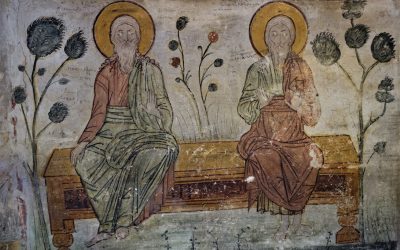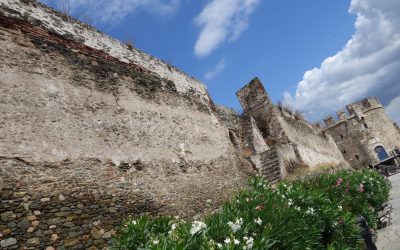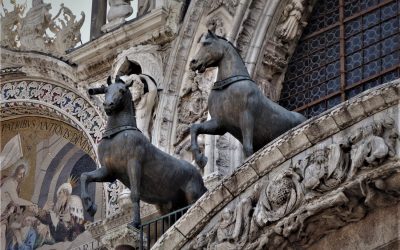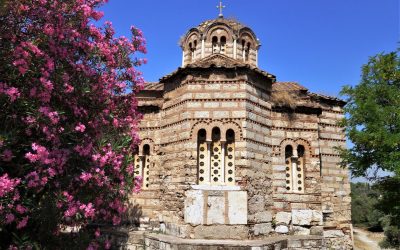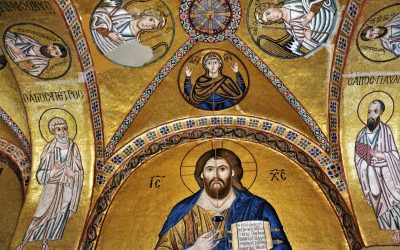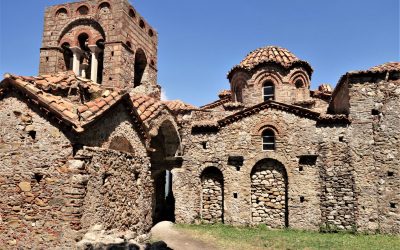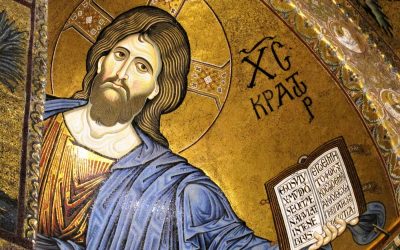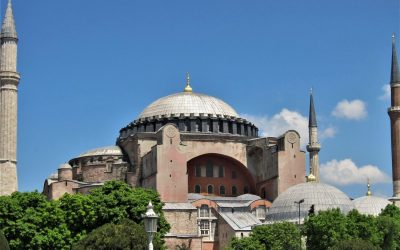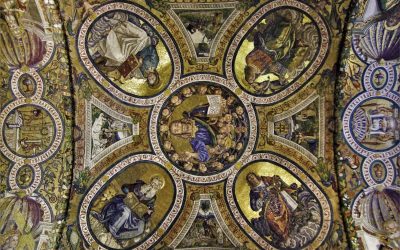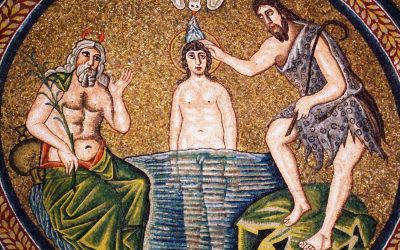Byzantium
When we started to think about travel to southern Europe in the warmer months of summer, it seemed natural for us to seek out the history of Ancient Greece and Ancient Rome as well as the glories of the Renaissance period. Perhaps with some Medieval Gothic cathedrals thrown in for good measure. There was 500 to 1,000 years or so of ‘Dark Ages’ in between that didn’t seem to hold much interest.
Some time around our second European trip (in 2008) we both read the book Justinian’s Flea by William Rosen. We learnt about the efforts of Emperor Justinian I (r. 527-565) to restore the Roman Empire, his fascinating wife Theodora, and a cast of other colourful characters. We also learnt about the Italian city of Ravenna which had been capital of the Western Roman Empire from 402 to 476, then became capital of the Ostrogothic Kingdom until it was re-conquered in 540 by Justinian’s Byzantines. And about its amazing mosaics.
That led us to read the book ‘Byzantium: The Surprising Life of a Medieval Empire’ by the British archaeologist and academic Judith Herrin. There’s a lovely anecdote in the introduction of her book:
One afternoon in 2002, two workmen knocked on my office door in King’s College, London. They were doing repairs to the old buildings and had often passed my door with its notice: ‘Professor of Byzantine History’. Together they decided to stop by and ask me, ‘What is Byzantine history?’ They thought it had something to do with Turkey. And so I found myself trying to explain briefly what Byzantine history is to two serious builders in hard hats and heavy boots. Many years of teaching had not prepared me for this.
The book she wrote in response to this interaction is an excellent primer for a general audience. It helped to shed much further light on a period of European history we didn’t know much about, and hadn’t thought about exploring before then.
On our next trip to Italy (in 2009) we sought out Early Christian Rome and visited Ravenna. That was enough to get us hooked. Subsequent trips led us to marvel at the Byzantine mosaics of Arab-Norman Sicily in Palermo and Monreale, and look at Venice in a very different way. We went to Turkey to see Istanbul and imagine it as Constantinople. On trips to Greece we sought out the World Heritage Byzantine sites of Moni Hosios Loukas, Mystras, Meteora, and Byzantine Thessaloniki. We were able to look beyond Ancient Athens and see Byzantine Athens.
So what are the things that have drawn us to Byzantium? The skill of the mosaicists, the beauty of the icons, and the stories and characters portrayed from a time when very few people could read or write. The ‘Tardis-like’ qualities of the buildings that always seem bigger on the inside. Small things, like the aesthetics of the jewellery. The magic of being in places that were conceived, designed, and built over 1,500 years ago and have somehow survived through thick and thin.
Beyond these specifics, two things stand out as we think back on the sum of our experiences. Firstly, how some of its most brilliant flowerings emerged through embracing rather than eradicating disparate influences. Arian and Orthodox in Ravenna. Greek, Arab, and Norman in Sicily. Secondly, how colourful female characters emerge in spite of the overwhleming predominance of old, bearded, black-clothed males. Galla Placidia and Theodora in Ravenna, Adelaide del Vasto in Sicily.
Over more than a decade we’ve found the pursuit of an interest in Byzantium to be particularly rewarding when travelling in Italy, Turkey, and Greece. It’s exposed us to a long, deep history that we were barely aware of beforehand. A history that is far less ‘dark’ and far more diverse than we could have imagined.
Key dates, people, and events related to the places we’ve visited are sumarised below, in chronological order.
- 313 Constantine the Great legalises christianity within the Roman Empire. His wife, Fausta, gives land for a papal residence and church to be built in Rome.
- 324 Constantinople is established as capital of the Eastern Empire (‘the new Rome’), on the site of a Greek city called Byzantium.
- 329 Saint Helena (Constantine’s mother) founds a church in Rome to house relics from the Holy Land.
- 380 Theodosius I makes christianity ‘state religon’ of the Roman Empire via the Edict of Thessalonica. Thessaloniki’s Byzantine Walls are commenced and the Roman Rotunda of Galerius is converted to a Christian Church.
- 395 The Roman Empire is split into east and west by Theodosius I.
- 402 Ravenna is established as capital of the Western Roman Empire when Emperor Honorius moves his court from Mediolanum (Milan).
- 410 Rome is sacked by the Visigoths.
- 413 Theodosius II builds the Theodosian Walls around Constantinople.
- 423-37 Galla Placidia in Regent of the Western Roman Empire and builds a mausoleum in Ravenna (though is buried in Rome).
- 470 Church of the Acheiropoietos is built in Thessaloniki.
- 490 Osios David (later Latomou Monastery) is built in Thessaloniki.
- 476 Barbarians led by Odoacer capture Ravenna.
- 493 Theodoric captures Ravenna and makes it capital of the Ostrogothic Kingdom, allowing Arian and Orthodox christians to co-exist.
- 526 Theodoric dies and is buried in Ravenna.
- 527 Justinian the Great becomes Emperor and sets out to restore the Empire.
- 535 Justinian’s general Belisarius captures Sicily.
- 537 The Aya Sofya is built in Constantinople.
- 540 Justinian’s forces capture Ravenna and with Theordora he commissions remarkable mosaic cycles in the Basilica San Vitale.
- 565 Justinian dies.
- 726 The first Doge of Venice is elected.
- 751 Ravenna is captured by the Lombards, ending its importance within the Byzantine Empire.
- 829 Relics of Saint Mark are smuggled from Alexandria to Venice and the Basilica San Marco is built.
- 975 Church of the Holy Apostles built in the Ancient Agora of Athens.
- 1011 Moni Hosios Loukas built to house the relics of Saint Luke of Steiris. His relics were thought to have healing properties which made it a pilgrimage site and brought great wealth to the monastery.
- 1048 The Normans sack Rome under Robert Guiscard.
- 1072 Guiscard and his brother, Roger I capture Sicily. Roger becomes Count of Sicily and embraces Greek and Arab influences to create a distinctive Arab-Norman style.
- 1081 Chora Church built in Constantinople.
- 1096-9 The First Crusade.
- 1101-12 Adelaide de Vasto (Roger I’s wife, Roger II’s mother) rules as regent of Sicily.
- 1130 Roger II designs the Capella Palatina in Palermo‘s Palazzo Normanni.
- 1184 William II completes the Cathederal of Monreale.
- 1204 The Fourth Crusade detours to sack Constantinople at the request of the Doge of Venice, Enrico Dandolo.
- 1248 The Frankish Prince William II of Villehardouin chooses to build his fortress at Mystras.
- 1321 Chora Church in Constantinople endowed with fine mosaics and frescos by the powerful Byzantine statesman Theodore Metochites.
- 1344 Monks from from Mount Athos bring a group of followers to Meteora and eventually founded the great Meteoron monastery. Increasing threats from Ottoman raiders made the inaccessible rock pillars of Meteora an ideal refuge with more than 20 monasteries being built.
- 1453 Ottomans capture Constantinople.
- 1460 Ottomans capture Mystras.
Meteora
Next day (Saturday) was the main event, visiting the World Heritage monasteries of Meteora which are built on top of rock pinnacles. It's possible to visit the site using public transport, but it's far easier with a car. We planned an anticlockwise route to visit five of the...
Byzantine Thessaloniki
Another day we took a 'Byzantine' slice through the city, checking out its Byzantine Walls and the Byzantine Museum. This was a fantatstic day. The wall painting ensembles, mosaics and frescoes of Thessaloniki's Byzantine churches and monasteries are among the great...
Byzantine Venice
Islands in the Venice lagoon were initially occupied by Veneti, a Celtic tribe living in the Po valley region and allied to the Roman Empire. They had to flee waves of Barbarian invasion as the Roman Empire fell and lagoon islands provided places of refuge. Invading Visigoths...
Byzantine Athens
This was our third stay in the city and we'd had enough time looking at the wonders of Ancient Greece to have the headspace for contemplating its Byzantine heritage. There are a few gems. The Church of the Holy Apostles sits in the southeast corner of the Ancient Agora. It...
Moni Hosios Loukas
From Athens we picked up a hire car at the airport and drove towards Delphi. On the way we stopped at Moni Hosios Loukas, one of three World Heritage monasteries from 11th and 12th centuries that are characteristic of the second golden age of Byzantine art. It has a beautiful...
Mystras
The World Heritage archaeological site of Mystras preserves the remains of a city with a remarkable six hundred year history, from its founding in 1248 to its abandonment in 1832 at the end of the Greek War of Independence . After the Fourth Crusade in which Constantinople was...
Arab-Norman Sicily
The mix of Byzantine, Arab, and Norman influences on Sicily from 535 to 1194 created an incredible artistic and architectural heritage that is unique. As part of Emperor Justinian's plan to reunite the eastern and western empires, his general Belisarius took the island of...
Constantinople
Modern Istanbul is ancient Constantinople, the epicentre of Byzantium. Its strategic position on the Bosphorous, connecting the Black Sea with the Mediterranean, ensured that it was an important place from at least 657 BC. It became seriously important in 324 AD when the...
Early Christian Rome
One of the reasons we chose to stay in this part of Rome is that it's a great place to see the trajectory of Christianity from minor cult in pagan Rome to state religon of an empire. Over a couple of days we walked between a series of buildings that illuminate this period of...
Ravenna
We spent a day exploring Ravenna's World Heritage Early Christian Monuments. Stepping off the train from Bologna you wouldn't guess that you were walking into a place that has played a signifcant role in European history. Modern Ravenna is unprepossessing at first...

